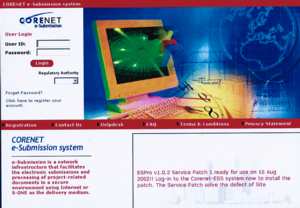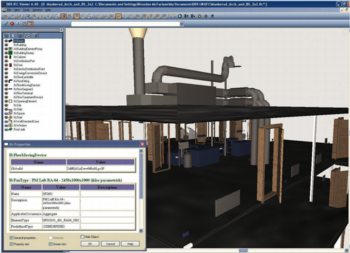Why the future is buildingSMART

The benefits of Industry Foundation Classes for building-services engineers — Christopher Groome.
Seamless data exchange along the design supply chain of building projects is bringing a range of benefits. CHRISTOPHER GRPOOME reports on what is happening worldwide.Save time, save money and secure the future. Swift sleek data-exchange protocols and the use of an integrated 3D model are the key to new ways of working that are already delivering efficiency gains. The international pan-industry group buildingSMART has been working for some years to make this a reality — and so it already is for enlightened clients and suppliers. In the early stages of its programme, common standards of data exchange (protocols known as Industry Foundation Classes or IFCs) were developed. They contain a wealth of information — not only design data, but also product and price information. They are ‘intelligent objects’ and show how one object is related to another — vital in a complex, heavily serviced building.
IFC software for building services IFCs are not a standalone product. They are incorporated within software products available in commercial packages. The providers themselves can seek certification, a seal of approval, from buildingSMART’s technical people, with input from users. Software incorporating IFCs is available for all the design disciplines. For building-services, Norwegian company Data Design System (DDS), has been operating in the UK for around a year and has pioneered the development of this technology for electrical, HVAC and plumbing systems. It has put on the market a software suite called Business Services Partner, which comprises three key modules: Electrical Partner; HVAC Partner (not yet available in the UK) and Piping Partner. Electrical Partner, like the rest of the suite, uses intelligent objects based on IFCs. It is designed to bridge the gap between calculation/design software and estimating and job-costing software and offers faster design and generation of drawings. Most significant, though, are the time savings to be made because information can easily be shared with others involved in the construction project. My industry colleague Brendan McFarlane, managing director, DDS, agrees with this: ‘Traditionally, contractors have found it necessary to re-enter data from the design, making the whole process more time-consuming. We also offer, on our website, a free downloadable IFC viewer, that enables building-services engineers to view IFC models even if they do not have design software that supports IFCs.’* Developing IFC-compliant software is not just for the big players, and there are opportunities for small niche players to develop IFC products — just as building-services engineers, big and small, can use IFC products.
Big players The big players are naturally better resourced to investigate the possibilities of IFC-compliant software. Atkins, a member of buildingSMART, has been exploring how IFC software can be used in the early stages of a building project to determine the environmental impact of the building. Building-services consultant ZPB (Zisman Bowyer & Partners), another member, is a strong supporter of using IFC software. David Saffin, senior partner, says that the firm ‘is a keen advocate of using object technology as a means of seeing greater supply-side integration. And the beauty of IFCs is the sheer amount of information they contain’. ZBP is moving away from traditional 2D drawings in favour of object modelling using IFC objects.
Flexibility As business manager of BuildingSMART, I cannot help being acutely aware of how progressive some of our industry counterparts are overseas. For example, they have often been quicker than UK companies to recognise the benefits of using IFCs in design — benefits such as flexibility. Let me explain the background. With IFCs, a 3D project model or building information model (BIM) can be created, so designers from different disciplines can work concurrently with greater ease. The BIM allows flexibility, fast iterations and the ability to handle design change late in the process. I was interested in the experience of Finnish client Joensuu University during the design of the Aurora project, a mixed-use facility due to complete in August 2006. As work progressed, analysis revealed that the building was too expensive and not energy-efficient. The flexibility offered by the model meant that design changes could be easily accommodated. In fact, the whole shape of the building was changed, and the whole facility is now more compact. Auli Karjalainen from Finnish property services agency Senate Properties tells me that the IFC-based BIM has made the whole design process far easier. ‘We were pleased with the way the model worked: the Aurora project is considered a successful example of a BIM in our part of the world.’ Global reach The reach of IFCs is now truly global as implementation takes off. The US Coast Guard, for example, is part-way through a massive change programme to link facilities more closely to operations. 3D CAD models using IFCs underpin the whole programme. Back in the old world, development of Akershus Hospital, near Olso, has harnessed IFC software to achieve a range of aims. The hospital has over a thousand unique rooms in which 50 000 articles are deployed, of which 20 000 were drawn in CAD. By setting up ‘object libraries’ (with the various items or objects expressed in IFC software), the scale of the work became more manageable. Secondly, responding to political demands for lower operational costs, the IFC project model helped reduce operational and whole-life costs. Thirdly, the new entrance building has been used for comprehensive testing of IFCs as a discrete project. This part of Akershus hospital contains an auditorium and canteen, and IFC software is being used for energy consumption, indoor climate, environmental impacts and fire hazard. 
Industry Foundation Classes were used in developing the design for the front entrance building of the Akershus Hospital in Oslo.
Examples of IFC software in use are starting to flow in surprising abundance. A castle in Bavaria used an IFC-based model to aid computer mapping of damage to allow essential repairs to be done to the facade. In Australia, as repairs and remediation are being done on the Sydney Opera House, the precise location of and access to services are being rigorously mapped, using IFC software. In Singapore and Norway, planning applications are submitted electronically in IFC-compliant software, something that building-services engineers may like to note. A pilot for a similar system is going on in New York — and what happens across the pond… 
In Singapore and Norway, planning applications are submitted electronically in IFC-compliant software. This is the Cornet e-Submission system used in Singapore.
Services and facilities management While the progress with using IFCs has been huge in the US and Nordic countries, there have been equally interesting developments in using a 3D building model or BIM in the UK. Taylor Woodrow Construction, another member of buildingSMART, has been involved in leading-edge activities. According to my industry colleague Jeff Stephens of Taylor Woodrow Construction, the company ‘recognised that the earlier barriers to reusing data for operation and maintenance (O&M) purposes were reduced as the software matured’. He adds. ‘So we led a joint industry project to explore the opportunities for IFC-model based operation and maintenance. We have a vested interest in ensuring that information is effectively captured for reuse. This information can then be used to populate the FM system, conventionally a lengthy process.’ As one of the project partners, I was able to follow the project in detail. Digbeth College in south Birmingham was used as a test case. An architectural model was created in ADT 2004. Designs for the HVAC system were then added to the model. The project concentrated on the 2-storey auditorium where the services were especially complex. The IFC model allowed clash detection, and as part of the project we also extracted some of the data to populate an FM system — showing that this task could be done in days instead of months. Pointing the way We can help secure the future of a building by using IFC data to simulate operation and maintenance. It brings far greater opportunity to manage lifetime costs and make a building more sustainable. Case studies from around the world show that clients and suppliers are realising the benefits of saving time and money by stipulating the use of IFC-compliant data. Building-services engineers who are not yet aware of the benefits of IFCs have a lot to gain by getting involved. Christopher Groome is business manager of BuildingSMART’s UK chapter and a long-time champion of supply-chain improvement. Details on BuildingSMART, IFCs and case studies from chris.groome@b-r-t.co.uk. Additional research by Betzy Dinesen, 020 8767 1372. A report on the IFC-mBomb project is available from Beryl Garcka, beryl.garcka@b-r-t.co.uk, or 020 8660 1631 (‘Life-cycle Data for Buildings: Opportunities for the IFC model-based operation and maintenance’). 
Even if they do not have design software that supports IFC models, building-services engineering can view IFC models using this downloadable free viewer from Data Design System.
Related links:
Related articles:











